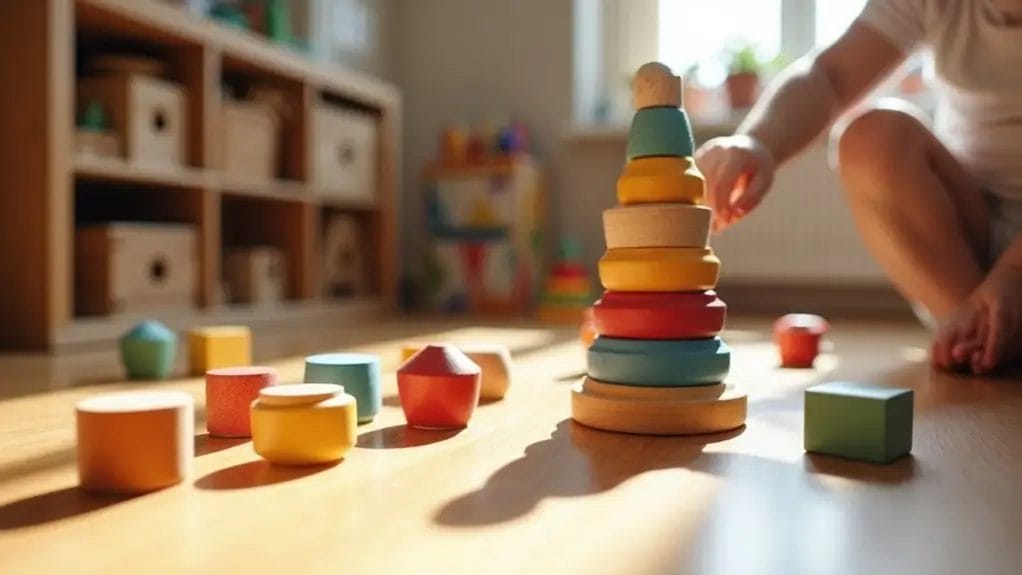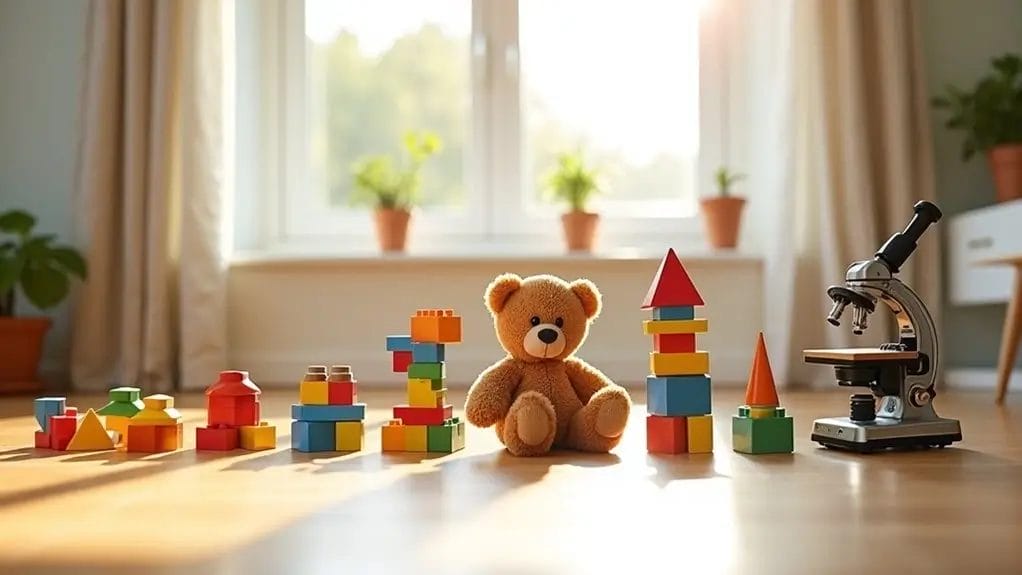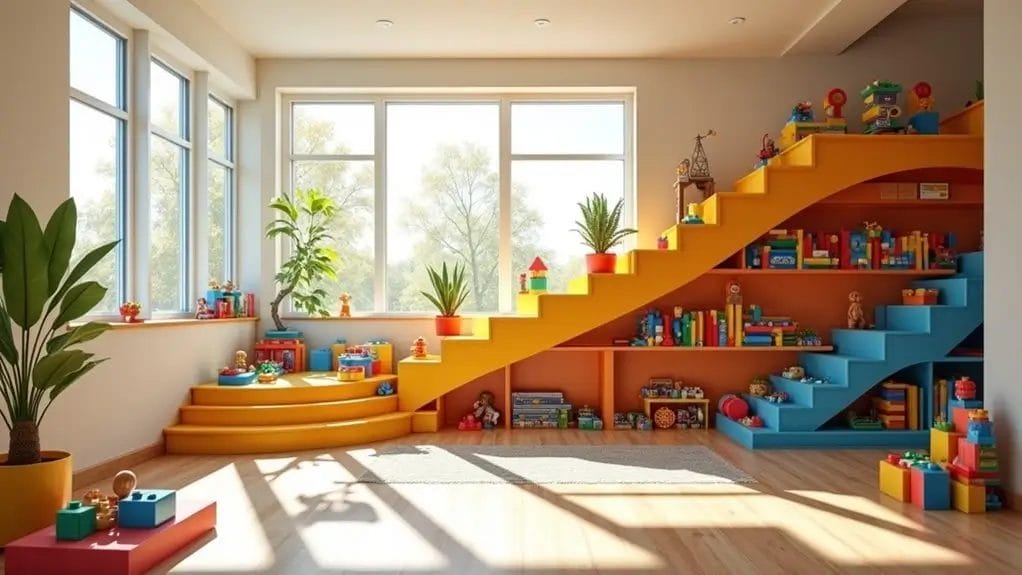
What Toys Can Grow With Your Child? A Comprehensive Guide
Have you noticed how quickly your child outgrows their toys, leaving you with a room full of abandoned playthings? But what if you could invest in toys that evolve alongside your little one?
Smart toy choices can engage your child through multiple developmental stages. These toys adapt to your child's expanding abilities and interests.
Let's explore how to select these versatile playtime companions. So, they'll keep your child challenged and entertained for years.
Key Takeaways
- Building blocks and puzzles adapt to different skill levels. Children can use them for increasingly complex designs as they develop.
- Art supplies like modeling clay, drawing materials, and craft kits encourage creativity. They also develop fine motor skills at various ages.
- Open-ended play sets, including pretend kitchens and tool benches, support imaginative play from toddler years through early elementary school.
- Board games with adjustable difficulty levels grow with children's thinking and social skills.
- Musical instruments develop coordination and artistic expression throughout childhood.
Understanding the Concept of Growth Toys

Growth toys are specially designed playthings that adapt and evolve alongside your child's developing abilities. They offer different ways to play as they progress through various developmental stages.
What Are Growth Toys?
Growth toys can evolve alongside your child's developmental stages. They offer different levels of engagement as skills advance. These open-ended toys feature adjustable complexity. So they can allow your child to discover new ways to play and learn over time.
Growth toys are unlike traditional toys with limited uses. Instead, they encourage creativity and experimentation through their multifunctional design.
They're built to last, using durable materials that withstand years of active play. They're a smart investment. Because they eliminate the need to replace toys as your child develops constantly.
Importance of Choosing the Right Toys
Selecting developmentally appropriate toys is essential to your child's learning journey. When you choose the right toys, you invest in their long-term development and create sustainable play experiences.
These versatile toys adapt to your child's developmental stages. They offer new challenges and opportunities for exploration as they advance. You can focus on open-ended ones that encourage problem-solving, creativity, and independent play.
By selecting high-quality and durable toys, you provide valuable tools. These tools support their thinking skills, motor skills, and imagination.
What Toys Can Grow With Your Child? Three Categories

You'll find three main categories when selecting toys that grow with your child. Educational toys adapt to advancing learning levels. Creative toys expand artistic expression, and physical activity toys challenge developing motor skills.
1. Educational Toys
Educational toys stand at the forefront of growth-oriented playthings. They offer children dynamic learning experiences that evolve with their development.
These versatile items adapt to your child's changing abilities. They present increasingly complex challenges that match their skill level.
Through open-ended play, your child can explore different scenarios and outcomes. This will strengthen their problem-solving abilities and creativity.
These educational toys also support multiple developmental areas simultaneously, from fine motor skills to critical thinking.
Their durable construction guarantees they'll last through years of active use. This makes them a wise investment in your child's growth and learning journey.
2. Creative Toys
Creative toys represent a dynamic category of growth-oriented playthings. They expand along with your child's imagination.
As your child develops, these toys offer endless possibilities through open-ended designs and versatile components.
Building sets, art supplies, and adaptable play materials encourage imaginative play. Meanwhile, they support various developmental skills simultaneously.
These toys are particularly valuable because they're crafted from durable materials. They promote independent thinking and self-directed exploration. So, they allow your child to discover new ways to interact with familiar objects.
As their cognitive abilities advance, children can create increasingly complex projects and scenarios.
3. Physical Activity Toys
Physical activity toys represent another essential category. They adapt to your child's developing strength and abilities.
From balance beams to climbing structures, these toys help your child's gross motor skills at every development stage.
You can find versatile options like swing sets and slides. These toys safely accommodate children from toddlerhood through their early years.
Simple equipment such as jump ropes and hula hoops offers varying levels of challenge. They help your child build coordination and fitness.
These physical activity toys also encourage social play. They let kids interact and develop teamwork skills while staying active. These make them valuable investments in your child's physical development.
Features to Look for in Growth Toys

When choosing toys that grow with your child, you'll want to focus on three essential features.
Versatility
Look for toys with various play possibilities, from simple tasks to complex challenges. The best versatile toys adapt seamlessly as your child grows. They support different interests and skill levels along the way.
Choose toys that encourage various forms of play, from solo exploration to collaborative activities.
Building blocks can start as stacking toys and evolve into complex construction sets. Art supplies can shift from basic scribbling to detailed creativity. This versatility ensures your investment stays valuable and entertaining over time.
Durability
Investing in growth toys requires careful attention to durability to ensure lasting value. When selecting play sets and developmental toys, focus on high-quality materials. So these toys can withstand constant use, drops, and rough handling.
You'll want items that are washable and easy to maintain. This ensures they stay hygienic through years of play. Look for sturdy construction with well-secured parts and reinforced connection points.
The best growth toys feature quality finishes that resist scratches and fading. Consider items with replaceable components, as this extends their lifespan.
Adaptability
The most valuable growth toys feature adaptable designs. So they can evolve with your child's developmental journey.
Consider a play gym that changes from a sensory space for newborns to an activity center for toddlers, supporting fine motor skills at every stage. Look for toys with adjustable difficulty levels. So, these toys can challenge your child as they learn new skills.
Look for versatile pieces that serve various functions. For example, building blocks work for simple stacking and complex engineering projects later.
When choosing adaptable toys, focus on those with clear progression paths. These toys keep your child's interest while encouraging independent exploration and creativity.
Top Growth Toys by Age Group
The best growth toys align with your child's developmental stages. They range from sensory-rich items to complex problem-solving toys.
Infants (0 - 12 months)
When selecting toys for infants aged 0-12 months, prioritize versatile items. These toys should stimulate many senses and support early developmental milestones.
Look for bright, colorful toys with varied textures and sounds. They can help kids explore their environment through sensory play. Choose durable items like soft blocks or shape sorters that can adapt as your baby grows.
Focus on toys that encourage grasping and manipulation. So your baby can build essential fine motor skills.
Activity gyms and rattles introduce cause-and-effect relationships. They'll foster cognitive development.
These foundational toys will grow with your infant. They'll become more complex play items as your child's skills develop.
Toddlers (1 - 3 years)
As toddlers enter their second year, it's essential to choose toys that grow with their quickly developing abilities.
Look for growth-oriented toys featuring easy-to-grasp pieces. These toys help develop fine motor skills and hand-eye coordination.
Choose versatile items that encourage creativity and imaginative play. They allow your child to explore different scenarios and solve problems independently.
Invest in durable toys that can handle active play while providing increasing complexity.
You'll want options that adapt to their expanding interests. These toys should support both physical and cognitive growth through open-ended play experiences.
Preschoolers (Age 3 - 5)
Preschoolers thrive with toys that provide layered complexity and adaptable play experiences. Open-ended toys encourage creativity and problem-solving skills.
Choose versatile toys that can grow with their skills. These toys should support various developmental stages and play scenarios. Look for durable construction sets and imaginative play items. So these items can withstand years of active use.
These toys not only foster independent exploration but also promote social interaction.
Early School Age (5 - 7 years)
In their early school years, children need toys that match their rapidly developing thinking and social skills.
Building sets with varying complexity levels offer perfect challenges. These toys encourage critical thinking while fostering creativity through open-ended construction.
Pretend play sets like play kitchens continue to be valuable. They support your child's developing social skills and understanding of real-world scenarios.
You should include educational games that combine learning with fun. Also, consider STEM-focused toys that adapt to their growing knowledge.
Physical activity toys can help develop coordination and gross motor skills.
Real-Life Benefits of Growth Toys
Your child's growth toys do more than entertain. They build essential cognitive abilities through problem-solving and creative exploration.
Enhance Cognitive Skills
When children engage with adaptable toys, they develop essential cognitive skills. As kids grow through different stages, these versatile toys present new challenges. They can enhance problem-solving abilities and critical thinking.
You'll notice your child exploring various scenarios and testing theories. They'll develop complex reasoning skills through sustained engagement with these toys.
Growth toys also strengthen spatial awareness, logic, and memory. Your child can discover innovative ways to play.
Collaborative interactions encourage them to communicate and negotiate with their peers. This helps them develop important social skills.
These cognitive skills create a foundation for lifelong learning through meaningful play experiences.
Foster Social Skills
Growth-oriented toys also create powerful opportunities for children to build lasting social connections.
When your child plays with these toys, they collaborate with others, share ideas, and solve challenges together. As children play pretend, they develop empathy by exploring various roles and perspectives.
These adaptable toys bridge different ages. They allow siblings and friends to interact meaningfully despite developmental gaps. Your child will learn sharing, negotiating, and solving conflicts while having fun.
These social experiences lay the groundwork for healthy relationships throughout their lives.
Encourage Emotional Development
Growth-oriented toys serve as powerful catalysts for emotional development. They offer children safe spaces to explore and understand their feelings. Through imaginative play, your child can act out different scenarios. This helps them process emotions and develop empathy for others.
They'll learn sharing, cooperation, and conflict resolution as they engage with these toys.
These toys also build resilience by presenting manageable challenges. They teach your child how to handle frustration and develop effective coping strategies.
Playing with familiar toys provides emotional security. At the same time, open-ended play helps them express themselves and build confidence.
Tips for Parents on Choosing Growth Toys
Let’s take a closer look at some key considerations for selecting the right toys.
Assess Interests and Developmental Needs
When choosing toys, it’s important to understand their current interests and developmental stage.
Watch how they play and what activities captivate them most. Notice which skills they're mastering and which ones they're working to develop.
Look for toys with various uses that can adapt to your child's changing abilities. Choose items that challenge them slightly beyond their current skill level. But the items still have to remain engaging.
Talk with your child about what excites them. Then, use these conversations to guide your toy selections. This approach guarantees the toys you choose will grow with your child meaningfully.
Involve Children in the Selection Process
Try to include your kids in the selection process. So, they'll develop a stronger connection to their toys and engage more deeply in play.
- Kids can start by sharing what activities they enjoy most.
- Guide them by comparing different options.
- Discuss how toys might adapt to their changing skills.
- Let them take part in shopping decisions, whether online or in stores.
This teamwork helps children learn to make decisions and ensures the toys support their growth.
Conclusion
Investing in growth toys offers lasting value for your child's development journey. By choosing adaptable toys, you support their learning while saving money. Remember to focus on open-ended options that encourage creativity and problem-solving.
Whether building blocks or educational games, these adaptable toys will continue engaging your child as they grow and explore.